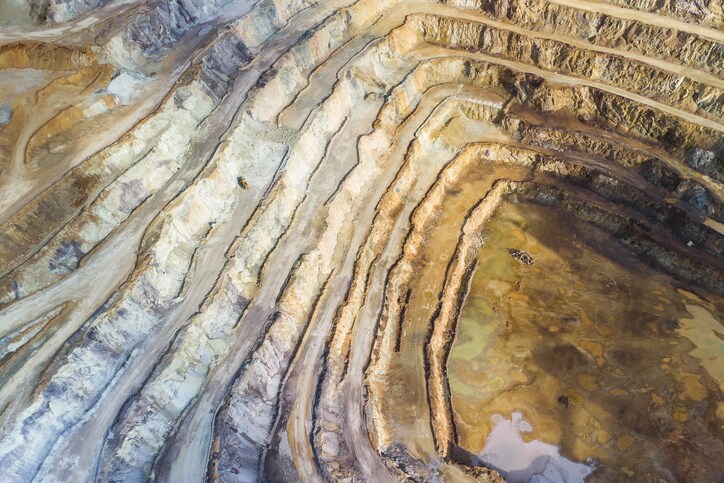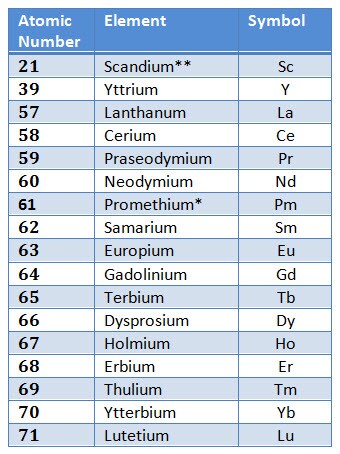 Rare Earth Elements (REEs) seem to always be in the news. The uncertainty surrounding metals demand, the mining market, and China’s economy all affect the value of rare earth elements. What isn’t uncertain though is that the demand for them will continue to increase. REEs have diverse applications that touch many aspects of modern life. With the rapid rise in demand for electronics in the automotive, military, clean energy, and medical industries – and the continuous innovation involved in “the internet of things” — rare earths will have to continue to be mined as the USGS reminds us that only limited quantities of rare earths are recovered from batteries, permanent magnets, and fluorescent lamps.
Rare Earth Elements (REEs) seem to always be in the news. The uncertainty surrounding metals demand, the mining market, and China’s economy all affect the value of rare earth elements. What isn’t uncertain though is that the demand for them will continue to increase. REEs have diverse applications that touch many aspects of modern life. With the rapid rise in demand for electronics in the automotive, military, clean energy, and medical industries – and the continuous innovation involved in “the internet of things” — rare earths will have to continue to be mined as the USGS reminds us that only limited quantities of rare earths are recovered from batteries, permanent magnets, and fluorescent lamps.
But do you even know what rare earth elements are?
According to the USGS, “The rare earths are a relatively abundant group of 17 elements composed of scandium, yttrium, and the lanthanides. (Try naming all 17 before looking at the chart below.) The elements range in crustal abundance from cerium, the 25th most abundant element of the 78 common elements in the Earth’s crust at 60 parts per million, to thulium and lutetium, the least abundant rare-earth elements at about 0.5 part per million. The elemental forms of rare earths are iron gray to silvery lustrous metals that are typically soft, malleable, and ductile and usually reactive, especially at elevated temperatures or when finely divided.”
And they are really not rare. They are just rarely mined because finding concentrations that are economically minable is unusual. Do you know all 17 elements? It’s a little tricky since one of them is usually not included because it is rare and unstable* and another does not occur in economic concentrations in the same geological settings**. Here they are in order of their atomic number on the periodic table.

Portable x-ray fluorescence (PXRF) analyzers are valuable tools to the mining and minerals community. Portable X-ray fluorescence (XRF) technology can be used in a wide range of mineralogical and geological exploration markets, one of which is the mining of Rare Earth Elements (REEs). XRF Technology is a non-destructive analytical technique used to determine the elemental composition of materials. XRF analyzers work by measuring the fluorescent (or secondary) X-rays emitted from a sample when excited by a primary X-ray source. Each of the elements present in a sample produces a set of characteristic fluorescent X-rays, or “unique fingerprints.” These fingerprints are distinct for each element, making XRF analysis an excellent tool for quantitative and qualitative measurements.
REEs rarely exist in pure form; they are usually concentrated in more than one mineral, and each mineral requires a different costly extraction technology and mineral processing. Geochemical exploration is the main method of REE exploration. Depending on the REE project type, portable XRF analyzers are useful instruments that can provide real-time, on-site assays of REEs and other elements in any type of geological samples.
The rare earths minerals summary report released by the USGS in January 2023 notes that when it comes to import sources “Rare-earth compounds and metals: China, 74%; Malaysia, 8%; Estonia and Japan, 5% each; and other, 8%. Compounds and metals imported from Estonia, Japan, and Malaysia were derived from mineral concentrates and chemical intermediates produced in Australia, China, and elsewhere…. Global mine production was estimated to have increased to 300,000 tons of REO equivalent. China’s Ministry of Industry and Information Technology raised 2022 quotas for rare-earth mining and separation to 210,000 tons and 202,000 tons of REO equivalent, respectively. The mine production quota was allocated to 190,850 tons of light rare earths and 19,150 tons of ion-adsorption clays.”
So how did you do? Could you name all 17 before reading the article? It’s rare that someone can name them all.
Editor’s Note: The article was originally published on Mar 3, 2016, by Chris Calam but has been refreshed and updated with the latest USGS information.






Astatine 85 is the rarest element , Your list has not mentioned it. so total is 18.
Hi Gautam —
Thank you for your comment. I have consulted one of our scientists and here is her comment:
Astatine (At) may be rarest naturally occurring element in the Earth’s crust, but it is a member of the halogen family (F, Cl, Br, I, At) and is presumed to have characteristics similar to other Group 17 elements.
The meaning of the word “rare” in the term “rare earth elements” does not relate to the scarcity of these elements. REE are defined by IUPAC (International Union of Pure and Applied Chemistry) as being the 15 lanthanides (atomic number 57-71) plus Sc (21) and Y (39). These elements are all lumped together as they tend to both occur together and have very similar chemical properties.
I hope that helps to clarify things.
Can anyone suggest how I can find all the “Neel temperatures” for all REE?
Gary — Let’s see if our readers can help.
Can anyone help me with where I can find the “Neel temperature” of all the REE in Centigrade if possible?
If no K is fine.
How can I find the “Neel temperature” of all REE ‘s?
Your help will be much appreciated.